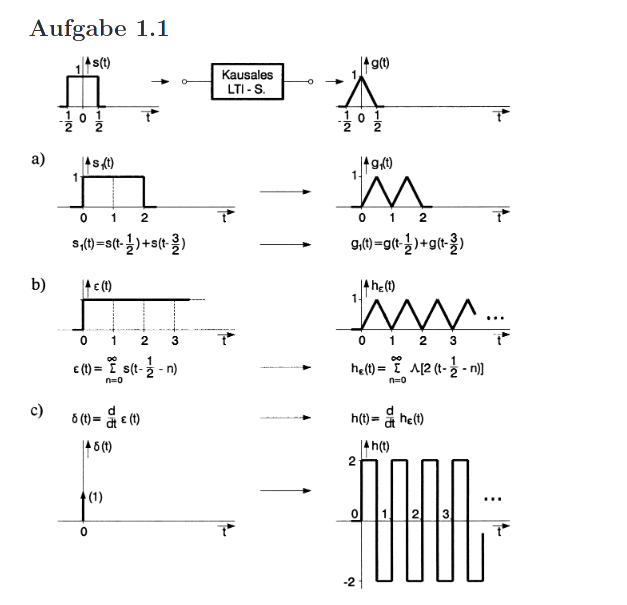EDIT : Based on RBJ's comment that the indicated the system cannot possibly be an LTI, due to the fact that the output spectrum contains frequencies that do not exist at the input spectrum..., I've looked at the input-output spectrums, and came to the following conclusion :
Given the input:
$$ s(t) = \begin{cases} { 1 ~~~,~~~-0.5 < t < 0.5 \\ 0~~~,~~~\text{otherwise} }\end{cases} \tag{1}
$$
and the output:
$$ g(t) = \begin{cases} { 2t+1 ~~~,~~~ -0.5 < t < 0 \\ 1-2t ~~~,~~~ ~~~~~~~~0 < t < 0.5 }\end{cases} \tag{2}
$$
The corresponding spectrums (apart from linear scale factors !) are :
$$ S(\omega) = \frac{ \sin(\omega /2) }{ \omega} \tag{3}$$
and
$$ G(\omega) = \left( \frac{ \sin(\omega/4) }{ \omega} \right)^2 \tag{4}$$
Now, the input spectrum contains all frequencies except the zeros of the sine function which occur at $\omega = 2\pi k$, whereas the output spectrum contains all frequencies except those $\omega = 4\pi k$. Therefore, RBJ is correct in his claim that this particular input-output pair violates the LTI principle of output cannot contain frequencies that do not exist at the input.
However, in my opinion, redefining the output triangular-pulse duration as
$$ \hat{g}(t) = \begin{cases} { 2t+1 ~~~,~~~ -1 < t < 0 \\ 1-2t ~~~,~~~ ~~~~~0 < t < 1 }\end{cases} \tag{5}
$$
eliminates the associated problem, as the output spectrum becomes:
$$ \hat{G}(\omega) = \left( \frac{ \sin(\omega/2) }{ \omega} \right)^2 \tag{6}$$
which includes all frequencies except at those $\omega = 2\pi k$. Thus the missing frequencies at the input are also missing at the output.
Hence, I would like to assume that there was a typo at the duration of the triangular-pulse output $g(t)$, and that otherwise the analysis based on LTI remains valid... Thanks to RBJ for the reminder... EDIT-1-ENDS
EDIT-2 :
However, now happens another problem. If the system is to remain LTI (so that subsequent analysis remains valid), then $\hat{g}(t)$ (the redefined $g(t)$) should be used in the remaning progress. But then the observed waveforms in the figures will be different from what's being drawn. Most notably, the step-response obtained in part-b, becomes a flat output (a unit-step with finite length triangular tails), and finally the impulse response found as step-response's derivative will be a single rectangular-pulse at the origin (and one more at positive infinity) and not a periodic waveform.
So I think the problem should be completely redefined to make any sense...
EDIT-2-ENDS
Your system is stated to be causal and LTI. And an example response for a single rectangular-pulse input $s(t)$ is provided to be a single triangular-pulse output $g(t)$:
$$g(t) = \mathcal{T}\{s(t)\} = s(t) \star h(t) $$
where $h(t)$ is the impulse response of the LTI system, and $\star$ denotes convolution.
The followings are easily deduced from the properties of LTI systems:
a-) Observe that $s_1(t)$ is given by a sum of two shifted $s(t)$ pulses side by side as:
$$ s_1(t) = s(t-0.5) + s(t-1.5)$$
then from the LTI property, conclude the output as:
$$g_1(t) = \mathcal{T}\{s_1(t)\} = \mathcal{T}\{s(t-0.5) + s(t-1.5)\} = g(t-0.5) + g(t-1.5) $$
the output for $s_1(t)$ consists of two triangular pulses repeated (and the origin is shifted).
b-) Now, instead of two pulses, consider an infinity of such rectangular pulses shifted to locate side by side. Then the output will also be infinity of triangular pulses located side by side, as given by the figures in the case b:
$$
\epsilon(t) = \sum s(t -0.5-n) \implies h_{\epsilon}(t) = \mathcal{T}\{ \epsilon(t) \}$$
$$
\begin{align}
h_{\epsilon}(t) &= \mathcal{T}\{ \sum s(t -0.5-n) \} \\
&= \sum \mathcal{T}\{s(t -0.5-n) \} \\
&= \sum g(t-0.5-n)
\end{align}
$$
incidentally, the signal $\epsilon(t)$ is a unit-step function, and the corresponding response $h_{\epsilon}(t)$ is known as step-response of an LTI system.
c-) then the impulse response of the LTI system can be found based on the relation of step-reponse to impulse-response. Namely, if $h_{\epsilon}(t)$ is the step-response of an LTI system, then the impulse response $h(t)$ is :
$$ h(t) = \frac{ d h_{\epsilon}(t)} {dt} $$
you can see from the figure in c-) that the impulse response $h(t)$ is indeed the differentiation of the step-response; i.e, the triangular pulses are converted into bipolar rectangular pulses, and they are repeated indefinetely at the rate of triangular pulses in the step-response. Hence, the figure in case-c.
or it could as well be directly verified as the differentitation property of convolution. Actually this property is a consequence of the differentiation property of the convolution operator...



